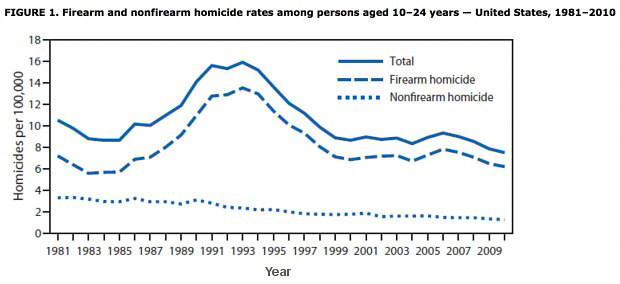

Anti-Gun Advocates Probably Won't Like This New CDC Report
![]()
A study done by The Institute of Medicine and National Research Council, described in our recent alert, was also hardly likely to have pleased the anti-gun factions!
![]()
By Jonathon M. Seidl, July 12th 2013
Article Source
The homicide rate for older children and young adults has hit its lowest point in at least three decades, but the decline has been slowing, according to a new government report.
In 2010, the homicide rate for victims ages 10 to 24 was less than half the rate seen in 1993, when there was an explosion in crime tied to crack cocaine.
The report released Thursday echoes earlier findings about a national decline in killings and other crimes, but offers a more focused look at what is one of the most affected groups. Ages 10 to 24 account for about a third of slaying victims. The highest homicide rates are consistently seen in people in their late teens and 20s.
"That's what drives the national numbers. That's the ballgame," said David Hemenway, director of the Harvard University's Injury Control Research Center. He was not involved in the new study.
The study finds that both firearm and nonfirearm homicide rates have been declining for the age group.

The figure above shows firearm and non-firearm homicide rates among persons aged 10-24 years in the United States during 1981-2010. The overall homicide rate among persons aged 10-24 years varied substantially during the 30-year study period. Rates rose sharply from 1985 to 1993, increasing 83% from 8.7 per 100,000 in 1985 to 15.9 in 1993. From 1994 to 1999, the overall rate declined 41%, from 15.2 per 100,000 in 1994 to 8.9 in 1999. (Source: CDC)
There are various theories for the drop in youth killings and other crimes since the early 1990s, ranging from the economy to police work or public health campaigns. None completely explain the trend, said Hemenway, a member of a National Academy of Sciences' group examining crime trends.
For the report, researchers from the Centers for Disease Control and Prevention searched a death statistics database that goes back to 1981.
About 4,800 youths ages 10 to 24 were killed in 2010, the most recent year in the analysis. That translates to a homicide rate of 7.5 per 100,000 people – the lowest since 1981. It also appears to be lower than rates in the 1970s, a CDC spokeswoman said.
But it hasn't been a steady trend down. The rate dropped a bit in the early 1980s and then rose sharply, peaking at about 16 per 100,000 in 1993. It plummeted for several years before the decline slowed. The rate inched down about 1 percent a year, on average, from 2000 to 2010, the CDC found.
The study showed youth homicide rates fell across the board – in males, females, whites, blacks and Hispanics. However, males and blacks continued to be killed at far higher rates than females or people in other racial and ethnic groups. The 2010 rate for blacks was nearly four times higher than the average for all youths that age.
The rate of gun-related slayings was about four times higher than of the rate of homicides using other weapons, although both declined.
Based on overall rates for 2010, homicide last year fell off the nation's top 15 causes of death for the first time in almost half a century. It continues to rank among the top three leading causes of death for people ages 10 to 24, however.

The figure above shows homicide rates among persons aged 10-24 years, by sex and age group, in the United States during 1981-2010. Homicide rates for males remained substantially higher than rates for females during 2000-2010. When homicide rates were examined by age group, rates for persons aged 20-24 years remained highest, and rates for persons aged 10-14 years remained lowest.

The figure above shows homicide rates among persons aged 10-24 years, by race/ethnicity, in the United States during 1990-2010. During 2000-2010, rates for blacks aged 10-24 years remained the highest and rates for whites in this age group remained the lowest.
CDC report: http://www.cdc.gov/mmwr
![]()

























